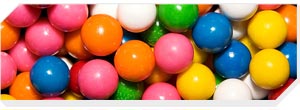Are there rocks in chewing gum?
Let me preface this post by saying that the title isn’t entirely accurate and it’s possible (depending on how you look at it) that it’s not at all accurate. Nonetheless, I’ve been battling this issue with a co-worker for some time now. Here’s the back story.
A long time ago, I watched a special on the Discovery channel or Science channel about rock quarries and in it, they talked about how they mine for the various types of useful rocks and in turn, what they use them for. After the show finished tell us about all of its exciting “rock facts,” it began to run the credits.
The producers of the show decided to use this time to make one small statement: “Rocks are even used in our everyday lives; some uses more common, others not so common such as rocks are used for the white powder on chewing gum.” (I’m sure this was not the statement verbatim, but the idea is on par.)

Anyway, somehow I was able to use this information at work and unbeknownst to me at the time, started a heated debate that continues to this day. At any rate, I never said there were rocks in chewing gum. In fact, I never said rocks were used as an ingredient!
The naysayers in this debate simply say that the white powder on gum is nothing more than sugar itself. Now, to their credit, Wrigley does state on their own website that this is the case for their products. In fact, someone who appears to be speaking on Wrigley’s behalf answered the question on Answers.com in regards to the white powder. They had this to say:
“All Wrigley gums are brushed with a rolling powder before they are encased in the foil wrappers that keep them fresh. On our sugared brands a granulated sugar, which has the appearance of confectionary sugar, is used. On our sugarfree brands a dusting of sugar substitute is used. The amount of the powder used may vary and depends on the handling of the operator. In general, our Extra® brand gums have more rolling powder brushed on them than other brands.”
Although this is true, it doesn’t mean that I (or for this matter, the tv show that told me this) is wrong! So, I set out to find some ground for my case and sure enough, I got a viable source. The website is SMI and their business is producing minerals for various uses and if you go to their website, you’ll see that they have outlined a very specific use of a mineral known as ground calcium carbonate for the powder on chewing gum, specifically Food Grade Vicron® GCCs. They also make reference to talc being used as well.
The purpose of these elements is to soak up any oils that would make the gum stick to the wrapper. A perfect summary of this fact is outlined directly on that link (text is no longer on this page):
“Talc is also used during gum base manufacture as a detackifier, to keep the gum base crumbs from sticking to each other. Both talc and calcium carbonate are used for dusting the sticks of gum — that is, the white powder on the product surface — to absorb any oils or other components that may migrate to the surface of the gum stick, which would make the gum adhere to the paper wrapper.”
Finally, I am putting this issue to rest and forever more, if anyone tells me again that I am wrong, I will forward them to this post. Thanks for listening (I guess, reading) my rant.






